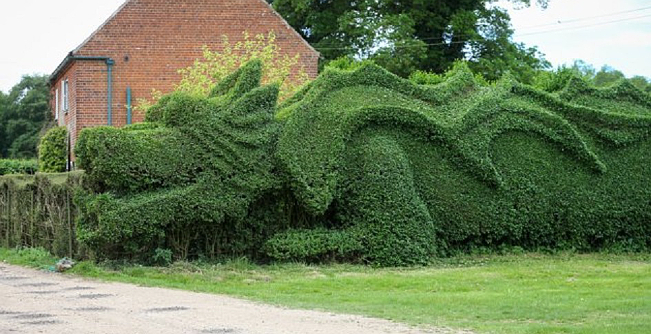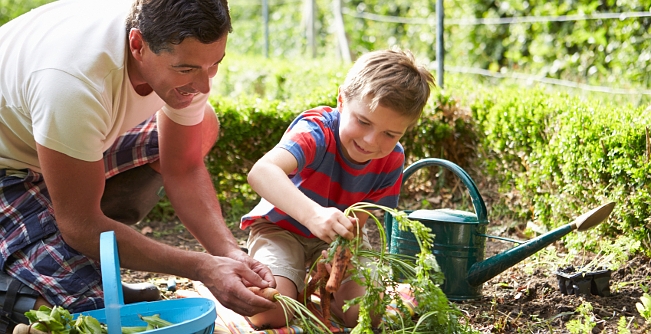There is no limit to green-fingered imagination, says Matt Rawlings.
What is a garden?
A perfectly-manicured patch of grass, which wouldn’t look out of place at Augusta – host golf course of the Masters? A contemporary and cool rockery? A busy hotch-potch of flowers, trees and ponds? A slab of tarmac surrounded by a few pots? A place for your kids to run, jump and enjoy themselves?
All of these are legitimate definitions, but some green-fingered folk will revolt at the thought of concrete and rocks as gardening, and will only use the word for a carefully-crafted multitude of beautiful blooms and verdant verges. Conversely there will be others who have set a limit for themselves in terms of time, space and effort – acres to be tended will exceed those boundaries and a patch of hard-standing will do just fine.
Then there are the mavericks, who take the concept of gardening to the next level and spin it on its head. They look at the garden as a toy, a horticultural sketchpad where foliage and fine art can be melded into weird and wonderful designs, with ornate sculptures, perfect patterns and eco-friendly streams and sheds, growing horizontally and vertically, on roofs and up walls.
Companies such Spalding Bulb have capitalised on the gardener’s market for the larger than life with their XXL packages whilst Design Toscano have focused on the bizarre, selling panthers, grand bears, zombies and yeti statues to liven up otherwise-dull areas. Others look at the garden as a storage space, but tailor their household items to fit in with the overall scheme – tyres, sinks, musical instruments (particularly pianos), boots, toilets, and even vehicle bonnets used as quirky flowerpots are no longer as silly an idea as once thought.
Gardens have been a source of sustenance since the dawn of time, but the sharing of advice and knowledge about growing more exotic fruits, vegetables and herbs has changed the depth of variety that one may find in the average patch.
For example, visitors can peruse examples of topiary in the grounds of many larger gardens or stately homes. Skilled shearers have trimmed and snipped away at trees, shrubs and hedges to depict shapes or objects. The most common shapes are cones, spirals or orbs, and the other usual suspects include rabbits, birds, shapes and buildings. But with a bit of work the skill can advance into a real talking point, a wonderful geometrical delight that crosses from gardening into art. Masterful gardeners across the world have used patience and a little forethought to depict faces the sizes of sheds, gigantic Disney characters, grand prix cars and Greek god statues.
These might be a long-term project because the bush has to grow to a requisite size to be shaped, as Norfolk farmer John Brooker showed. At the start of the 21st century, Mr Brooker decided that his rectangular front hedge was boring and very average. So he started sculpting and snipping, and now, 13 years on, a fearsome 150-ft long dragon stands in its place. The impressive beast, complete with bulging eyes and crested back, is no doubt a talking point for anyone strolling through the quiet village of East Rudham.

Seventy-five year old Mr Brooker said that he spends up to three days every two to three weeks perfecting the fairytale design, with help from his wife who used to be a graphic designer and has seen off four electric hedge trimmers. He believes that the titanic topiary was inspired by his days serving in the army in Malaysia and in his words, his labour of love has also impressed his wife as it gives her “something interesting to look at.”
Another example of utilising long and thin gardening dimensions could be seen in a garden owned by the Tophams, who hit the national headlines when they planned to sell their cottage in York with its adjoining garden – measuring 30ft wide and three-quarters of a mile long. The curiously-shaped ‘landing strip’ took them 30 seconds to cross, but half an hour to walk to the end.
Taking it on a stage, most gardens that are very unusual have been turned into open areas for charity or posterity, as part of National Trust or English Heritage property. Godinton Gardens in Ashford features giant lizards and animals made purely from bottle tops. Boughton House in Kettering boasts a giant inverted pyramid, sloping down to a mirror of water reflecting the sky. The Barbara Hepworth Museum and Sculpture Garden in St Ives regularly hosts works from the Tate Gallery.
What about those who see the garden as more than just a place to grow bushes, show off sculptures, or relax – but as somewhere to live?
In 2003 Simon and Jasmine Dale decided to restructure their lifestyle, throwing off the shackles of the mortgage and job dissatisfaction to build a home, garden and job all in one.
They spent just £3,000 building their brilliant ‘hobbit house’ in Wales. It is essentially a house dug into the hillside, almost hidden in grass and flowers and other natural elements. There’s a compost toilet, a fridge cooled by air coming underground through the foundations, and straw bales built into the walls, floor and roof. In effect, the garden and home are as one.
The couple have now moved on to another project, a more advanced communal version which also incorporates eco-friendly principles of sustainability in a beautiful rural setting. Built with the help of, and for, other residents, each plot is dedicated to growing food, and land-based businesses and enterprises including fruit and vegetable production, livestock and bees, and woodland and willow crafts for visitors.
Jasmine said: “Mostly it seems it’s fear that keeps people locked into consuming…there’s plenty of inspiration out there if people need encouragement to take a leap in their lives, change things and make a difference.”
A combination of talent, effort and resolve has created some spectacular designs, which can be shared in the blink of an eye online or through open gardens projects. It’s not just the finished project that brings these magicians joy, but the actual process of creation as well. Gardening is one of the nations favourite hobbies and is a great activity to share with your son or daughter.
The BBC has put together a comprehensive guide of great activities in the garden that can be shared with your child. They’ll be sure to get them learning and enjoying themselves outside, and what could be better than that? Take a look at the activities yourself here.








